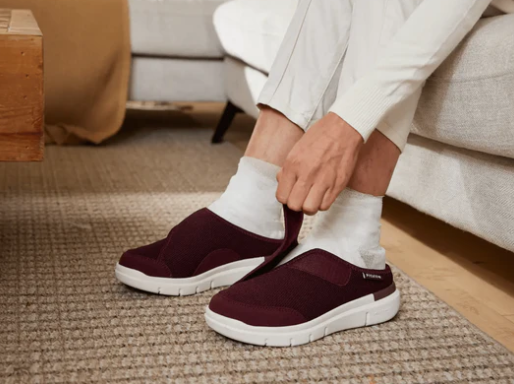For people living with diabetes, foot care is a daily priority. When neuropathy enters the picture, it becomes even more critical. Diabetic neuropathy can cause numbness, tingling, or pain in the feet, making it difficult to sense pressure or injury. The right pair of shoes can protect your feet, improve your balance, and make walking more comfortable.
This guide explores the best shoes for diabetics with neuropathy uk, focusing on key features, comfort technologies, and practical tips for choosing the right pair — all without sales charts or product links.
Understanding Neuropathy and Why Footwear Matters
Neuropathy affects the nerves that carry signals between the feet and the brain. As sensation decreases, small injuries or pressure points can go unnoticed and develop into serious problems like ulcers or infections.
Good diabetic footwear helps prevent this by reducing friction, supporting the foot’s structure, and improving circulation. The right shoes act as both protection and therapy — cushioning sensitive nerves while giving the foot a stable foundation.
Key Features to Look for in Diabetic Shoes
When selecting shoes for neuropathy, not all “comfortable” shoes will do. Here’s what to prioritise:
1. Extra Depth and Wide Toe Box
Diabetic neuropathy often comes with swelling, bunions, or hammertoes. Shoes with extra depth and a wide toe box allow the toes to move freely without rubbing against the sides or top of the shoe. This space prevents blisters and pressure sores.
2. Soft, Seam-Free Interiors
Even a small seam can cause irritation or wounds on sensitive skin. Look for shoes with smooth, padded interiors that minimise friction. Many diabetic-friendly models use stretchable fabrics that adapt to your foot shape.
3. Cushioning and Shock Absorption
Shoes with memory foam or EVA midsoles reduce pressure on the soles and cushion every step. Proper cushioning is essential for neuropathy, as the loss of sensation can make feet vulnerable to impact.
4. Stable and Supportive Soles
Balance can be affected by neuropathy, so a supportive, stable sole helps prevent falls. Look for shoes with a wide base and good traction, especially for slippery UK pavements during winter.
5. Adjustable Fit
Swelling can vary throughout the day, so adjustable closures like Velcro straps or stretchable uppers help you get the perfect fit without tightness.
6. Breathable and Moisture-Wicking Materials
Feet affected by diabetes are more prone to sweating and fungal infections. Choose shoes made from breathable mesh, leather, or other materials that help keep feet dry.
7. Removable Insoles for Orthotics
If you wear custom insoles or diabetic orthotics, removable footbeds make it easy to replace the insole and ensure proper alignment.
Styles of Shoes for Neuropathy
There’s no one-size-fits-all solution. Depending on your lifestyle, you can find neuropathy-friendly shoes in different styles:
- Walking shoes: Perfect for daily errands and exercise. They offer excellent shock absorption and arch support.
- Casual trainers: Comfortable and supportive for everyday wear. Some come with extra-wide options.
- Dress shoes: Diabetic-friendly dress styles now include hidden comfort technology without sacrificing appearance.
- Winter boots: For cold UK weather, insulated diabetic boots with non-slip soles and roomy interiors are ideal.
Everyday Tips for Choosing the Right Pair
- Shop later in the day – Feet swell during the day, so try shoes on in the evening for a more accurate fit.
- Wear diabetic socks – These provide extra cushioning and help you test the true comfort of your shoes.
- Check your feet daily – Even with the best shoes, monitor for redness, calluses, or sores.
- Avoid tight or pointed shoes – Pressure points can worsen neuropathy symptoms.
- Replace worn-out shoes regularly – Worn soles can create uneven pressure and increase the risk of injury.
Choosing the Best Option for You
When comparing diabetic shoes for neuropathy, focus less on brand names and more on comfort and function. The best pair should feel like an extension of your foot — secure, soft, and pressure-free.
For many in the UK, options that combine orthopedic design with everyday style work best. Look for brands offering wide or extra-wide fits, adjustable fastenings, and breathable materials.
If you’re unsure which fit suits your needs, consider visiting a podiatrist or a specialised footwear shop that provides foot assessments. Some NHS clinics and diabetic centres also offer guidance on approved footwear for neuropathy patients.
Final Thoughts
Neuropathy can make walking painful and risky, but with the right shoes, you can regain confidence and comfort. The best shoes for diabetics with neuropathy in the UK are those that prioritise protection, cushioning, and fit.
Think of your shoes as medical support rather than just fashion — a tool to keep your feet healthy and safe. Whether you’re out walking, travelling, or staying active, investing in proper diabetic footwear is one of the smartest steps you can take toward long-term foot health.





Comments